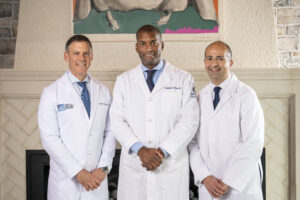AC Joint Injuries Affect Both College and Professional Quarterbacks
Sports medicine became a part of this past weekend’s featured college football battle between the Oklahoma Sooners and Texas Longhorns when star quarterback Sam Bradford aggravated his shoulder injury.
He absorbed a big hit from defensive back Aaron Williams on the same shoulder he injured last year after a tackle in a game against BYU. He had suffered a “shoulder separation,” or injury to his AC (“acromio-clavicular”) joint – a relatively common occurrence in football and hockey players. Similar injuries have recently affected NFL quarterback Eli Manning and Michigan’s star freshman quarterback Tate Forcier.
With “shoulder” or AC separations, the joint between the collarbone (“clavicle”) and shoulder blade (“scapula”) is injured. The ligaments and capsule connecting the bones can be injured to variable degrees depending upon the severity of the injury. It is commonly caused by a fall directly on the “point” of the shoulder or a direct blow, as occurs during a quarterback sack in football or check into the boards with hockey. Disruption of the AC joint results in significant pain and tenderness at the front of the shoulder joint. The pain is most severe when an athlete attempts overhead movements or throwing, and is even sensitive to the pressure of protective padding or pressure in the area. As the AC joint is relatively superficial, separation injuries are usually accompanied by a “bump” from the prominence of the collarbone at this location, and can be clearly seen as asymmetric from the uninjured side. Point tenderness to this location usually confirms the diagnosis clinically. Radiographs are helpful in ruling out associated fractures and in grading the severity of the separation.
In general, most AC injuries can be treated without surgery, but it depends on the severity of the injury. Low grade injuries will typically heal with rest and rehabilitation, but may be accompanied by the slight cosmetic deformity of a bump at the location of separation. Higher grade injuries, however, often do require surgery to reduce the joint and normalize the kinematics between the shoulder and arm – something that is particularly important to tennis players, baseball pitchers, and quarterbacks. The outcomes are generally good, and most athletes recover with full function of the shoulder.
Get a Telehealth Appointment or Second Opinion With a World-Renowned Orthopedic Doctor
 Telehealth appointments or Second Opinions with a top orthopedic doctor is a way to learn about what’s causing your pain and getting a treatment plan. SportsMD’s Telehealth and Second Opinion Service gives you the same level of orthopedic care provided to top professional athletes! All from the comfort of your home.. Learn more via SportsMD’s Telemedicine and Second Opinion Service.
Telehealth appointments or Second Opinions with a top orthopedic doctor is a way to learn about what’s causing your pain and getting a treatment plan. SportsMD’s Telehealth and Second Opinion Service gives you the same level of orthopedic care provided to top professional athletes! All from the comfort of your home.. Learn more via SportsMD’s Telemedicine and Second Opinion Service.

